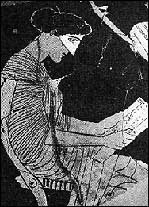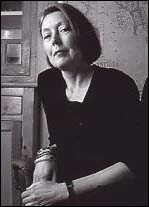
Our understanding of Sappho, her art, and her life and times is similarly incomplete. Moderns revere her as the original lyricist, one of the first great practitioners of the poetry of intimacy and private emotion, but many of her songs seem to have been composed for public occasions (weddings, for example) and her life and career probably took place within an institution that had a specific social function -- educating girls from the elite of a prosperous island society. Her poems refer to friends, lovers, a brother, a husband -- but it's hard to know whether these were "real" people or part of a story being told. Even when a fragment is relatively intact, interpretation remains difficult. In her famous song to Aphrodite, for instance, is she asking the goddess to cast a spell on a girl who Sappho adores, but who doesn't adore her? Or does the poem, rather, express an ancient belief in erotic justice -- every heartbreaker sooner or later gets their own heart broken? 1
Anne Carson is the author of seven books of poetry and prose, including Autobiography of Red, Eros the Bittersweet, and The Beauty of the Husband. Sappho has appeared often in Carson's earlier work, and her new translation, If Not, Winter, suggests the culmination of a life-long interest in her 7th century (B.C.) predecessor. Many will want this book because it is the latest work by a "great original," as Harold Bloom has described Carson, and her translations -- while true to the literal meaning of the Greek text -- are energized by her distinctive voice, her blend of austerity and intensity, and her Centaur-like sensibility: half avant-garde, half classical. As in her own poetry, Carson's style here conveys a powerful sense of controlled intensity:
If Not, Winter contains all the available fragments, from the mostly intact to the barely there (the last several pages collect isolated phrases or single words), and it includes the ancient Greek originals alongside Carson's renditions. That's a luxury few publishers are willing to indulge, but it's a great addition. This translator seems intent not only on offering up a "finished product", impressive as that is, but also on conveying the elusiveness and uncertainty of the texts. Some Like Carson, Stanley Lombardo in his new Sappho: Poems and Fragments 3 is less interested in trying to rebuild an ancient lost whole than in engaging "our momentary and receding relationship to the shattered fragments of the past." He has assembled seventy-three of the more intact texts into something resembling a modern poetry book -- that is, something which a reader can approach without necessarly having an extensive knowledge of ancient Greek lyric poetry, and without an overload of preconception or expectation. Lombardo has an ongoing fascination with recovering the oral and performative qualities of ancient poetry, and his translations, with their rhythmic phrases and sound textures, reward being read aloud. He finds a balance between rendering the poetry in a contemporary American idiom and preserving its ancient, remote qualities:
The volume benefits from an intelligent and concise introduction by Pamela Gordon. Gordon summarizes many of the ongoing critical debates about particular poems, interpreting Sappho's work as a whole, her relationship to 7th century Mytlinenean society, and her sexuality. And she provides a valuable list of Those wanting to know more about the historical background of the fragments will find much of interest in Margaret Reynolds' A Sappho Companion. Reynolds explores the different ways -- fair and unfair, accurate or ridiculous -- in which people across the eras have interpreted Sappho. She debunks some of the overly easy explanations -- for example, that Sappho's works were destroyed en masse by the early church fathers, in a fit of pious fervor. (The early Christian era, it's true, was not a very receptive environment for a female lyricist who sang of carnal desires and passions, but Reynolds points out that a comparatively mundane culprit -- a change in papyrus technology -- was more directly to blame). The Companion also includes an anthology of various efforts, from the classical period to our own, at translating the poet. Many of these inevitably sound tedious, unintentionally humorous, or just plain dated -- caught up in the mannerisms and preoccupations of other eras. Earlier Sappho aficionados had few qualms about dressing her up as an eighteenth century aristocrat, Renaissance shepherdess, or Parisian decadent, but the net effect of these diverse Sapphos isn't exactly to make us more confident about our own attitudes. Translation, especially of ancient, fragmentary texts, is a mercurial enterprise. That's part of its pleasure. 1. See Carson, Anne, "The Justice of Aphrodite in Sappho 1," Transactions of the American Philological Association 110 (1980): 135-42 2.Carson, Anne, If Not Winter: Fragments of Sappho. New York: Alfred A. Knopf (2002) 3. Lombardo, Stanley, trans. and Warden, Susan, ed., Sappho: Poems and Fragments. Indianapolis: Hackett Publishing Co. (2002) |
||||||||||||||||||||||||||||||||||||||||
 |
||||||||||||||||||||||||||||||||||||||||


